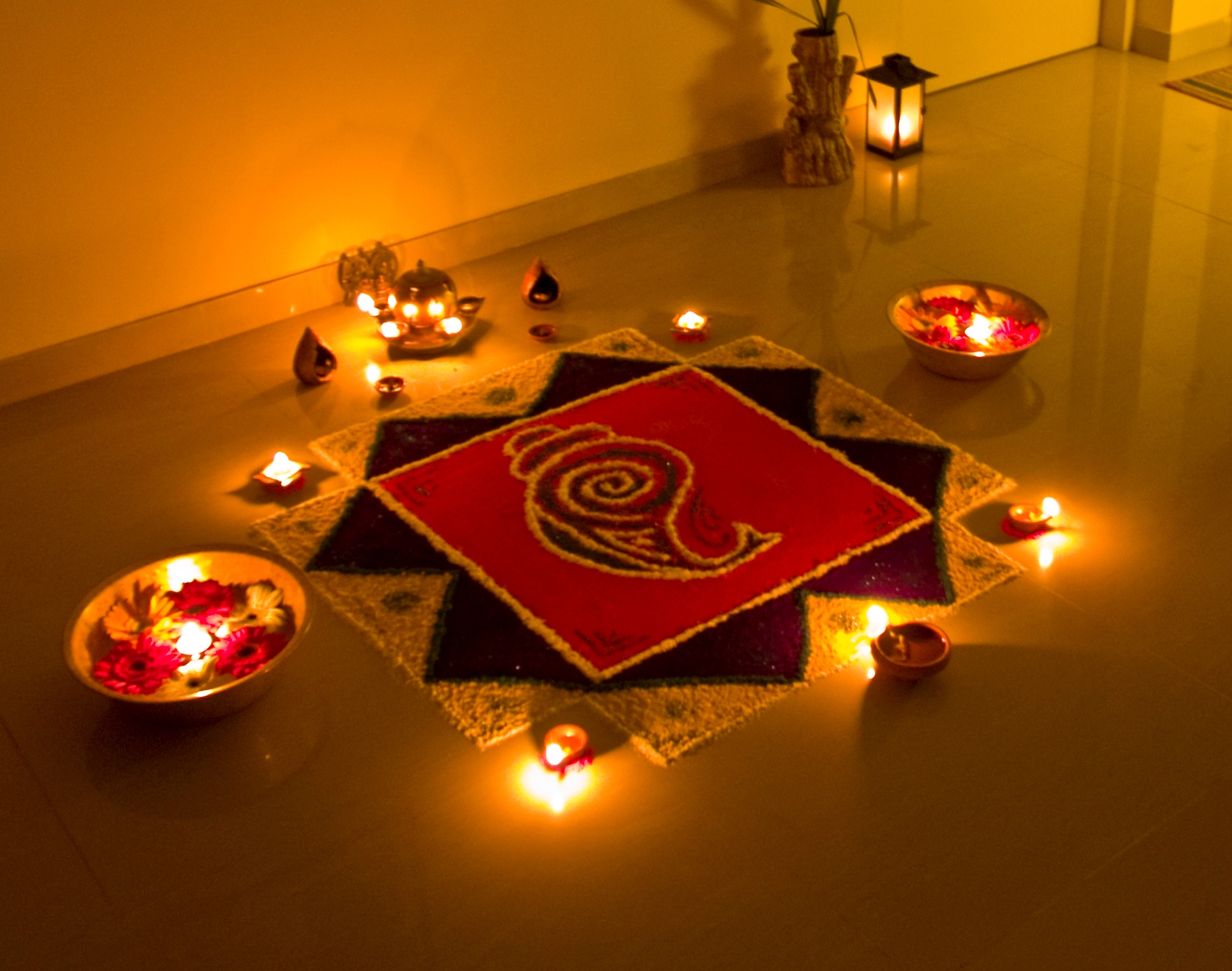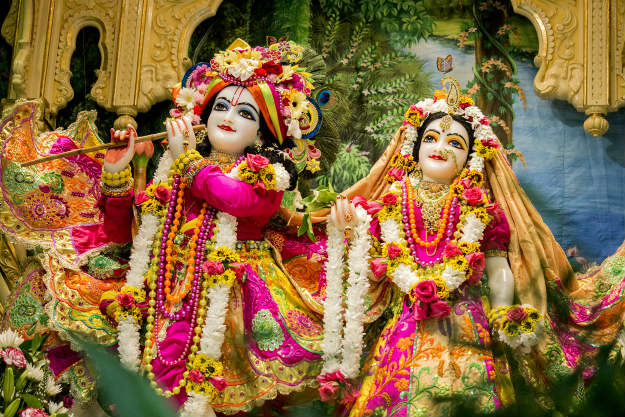Diwali, Divali, Deepavali is the Hindu festival of lights, usually lasting five days and celebrated during the Hindu Lunisolar month Kartika (between mid-October and mid-November).One of the most popular festivals of Hinduism, Diwali symbolizes the spiritual “victory of light over darkness, good over evil, and knowledge over ignorance”.The festival is widely associated with Lakshmi, goddess of prosperity, but regional traditions connect it to Sita and Rama, Vishnu, Krishna, Yama, Yami, Durga, Kali, Dhanvantari, or Vishvakarman.
In the lead-up to Diwali, celebrants will prepare by cleaning, renovating, and decorating their homes and workplaces. During the Diwali people wear their finest clothes, illuminate the interior and exterior of their homes with diyas (oil lamps or candles), offer puja (worship) to Lakshmi, the goddess of prosperity and wealth, light fireworks, and partake in family feasts, where mithai (sweets) and gifts are shared. Diwali is also a major cultural event for the Hindu and Jain diaspora from the Indian subcontinent.
The five-day long festival originated in the Indian subcontinent and is mentioned in early Sanskrit texts. Diwali is usually celebrated eighteen days after the Dussehra (Dasara, Dasain) festival, with Dhanteras, or the regional equivalent, marking the first day of the festival when celebrants prepare by cleaning their homes and making decorations on the floor, such as rangoli. The second day is Naraka Chaturdashi, or the regional equivalent which for Hindus in the south of India is Diwali proper. Western, central, eastern and northern Indian communities observe main day of Diwali on the third day, the day of Lakshmi Puja and the darkest night of the traditional month. In some parts of India, the day after Lakshmi Puja is marked with the Govardhan Puja and Balipratipada (Padwa), which is dedicated to the relationship between wife and husband. Some Hindu communities mark the last day as Bhai Dooj or the regional equivalent, which is dedicated to the bond between sister and brother, while other Hindu and Sikh craftsmen communities mark this day as Vishwakarma Puja and observe it by performing maintenance in their work spaces and offering prayers.
History
The Diwali festival is likely a fusion of harvest festivals in ancient India. It is mentioned in Sanskrit texts such as the Padma Purana, the Skanda Purana both of which were completed in the second half of the 1st millennium CE. The diyas (lamps) are mentioned in Skanda Kishore Purana as symbolising parts of the sun, describing it as the cosmic giver of light and energy to all life and which seasonally transitions in the Hindu calendar month of Kartik.
King Harsha refers to Deepavali, in the 7th century Sanskrit play Nagananda, as Dīpapratipadotsava (dīpa = light, pratipadā = first day, utsava = festival), where lamps were lit and newly engaged brides and grooms received gifts. Rajasekhara referred to Deepavali as Dipamalika in his 9th century Kavyamimamsa, wherein he mentions the tradition of homes being whitewashed and oil lamps decorated homes, streets and markets in the night.
Diwali was also described by numerous travellers from outside India. In his 11th century memoir on India, the Persian traveller and historian Al Biruni wrote of Deepavali being celebrated by Hindus on the day of the New Moon in the month of Kartika. The Venetian merchant and traveller Niccolò de’ Conti visited India in the early 15th-century and wrote in his memoir, “on another of these festivals they fix up within their temples, and on the outside of the roofs, an innumerable number of oil lamps… which are kept burning day and night” and that the families would gather, “clothe themselves in new garments”, sing, dance and feast. The 16th-century Portuguese traveller Domingo Paes wrote of his visit to the Hindu Vijayanagara Empire, where Dipavali was celebrated in October with householders illuminating their homes, and their temples, with lamps.
Islamic historians of the Delhi Sultanate and the Mughal Empire era also mentioned Diwali and other Hindu festivals. A few, notably the Mughal emperor Akbar, welcomed and participated in the festivities, whereas others banned such festivals as Diwali and Holi, as Aurangzeb did in 1665.
Publications from the British colonial era also made mention of Diwali, such as the note on Hindu festivals published in 1799 by Sir William Jones, a philologist known for his early observations on Sanskrit and Indo-European languages.In his paper on The Lunar Year of the Hindus, Jones, then based in Bengal, noted four of the five days of Diwali in the autumn months of Aswina-Cartica [sic] as the following: Bhutachaturdasi Yamaterpanam (2nd day), Lacshmipuja dipanwita (the day of Diwali), Dyuta pratipat Belipuja (4th day), and Bhratri dwitiya (5th day). The Lacshmipuja dipanwita, remarked Jones, was a “great festival at night, in honor of Lakshmi, with illuminations on trees and houses”.
Religious Significance
The religious significance of Diwali varies regionally within India. The festival is associated with a diversity of deities, traditions, and symbolism. These variations, states Constance Jones, may reflect diverse local autumn harvest festivals that fused into one pan-Hindu festival with a shared spiritual significance and ritual grammar while retaining local traditions.
One tradition links the festival to legends in the Hindu epic Ramayana, where Diwali is the day Rama, Sita, Lakshman and Hanuman reached Ayodhya after a period of 14 years in exile and Rama’s army of good defeated demon king Ravana’s army of evil.
As per another popular tradition, in the Dwapara Yuga Period, Vishnu as incarnation of Krishna killed the Demon Narakasura, who was evil king of Pragjyotishapura, near present-day Assam and released 16000 girls captivated by Narakasura. Diwali was celebrated as a significance of triumph of good over evil after Krishna’s Victory over Narakasura. The day before Diwali is remembered as Naraka Chaturdasi, the day on which Narakasura was killed by Krishna.
Many Hindus associate the festival with Lakshmi, the goddess of wealth and prosperity, and wife of Vishnu. According to Pintchman, the start of the 5-day Diwali festival is stated in some popular contemporary sources as the day Goddess Lakshmi was born from Samudra manthan, the churning of the cosmic ocean of milk by the Devas (gods) and the Asuras (demons) – a Vedic legend that is also found in several Puranas such as the Padma Purana, while the night of Diwali is when Lakshmi chose and wed Vishnu. Along with Lakshmi, who is representative of Vaishnavism, Ganesha, the elephant-headed son of Parvati and Shiva of Shaivism tradition, is remembered as one who symbolises ethical beginnings and the remover of obstacles.
Hindus of eastern India associate the festival with the goddess Durga, or her fierce avatar Kali (Shaktism), who symbolises the victory of good over evil. Hindus from the Braj region in northern India, parts of Assam, as well as southern Tamil and Telugu communities view Diwali as the day the god Krishna overcame and destroyed the evil demon king Narakasura, in yet another symbolic victory of knowledge and good over ignorance and evil.
Trade and merchant families and others also offer prayers to Saraswati, who embodies music, literature and learning and Kubera, who symbolises book-keeping, treasury and wealth management. In western states such as Gujarat, and certain northern Hindu communities of India, the festival of Diwali signifies the start of a new year.
Mythical tales shared on Diwali vary widely depending on region and even within Hindu tradition, yet all share a common focus on righteousness, self-inquiry and the importance of knowledge, which, according to Lindsey Harlan, an Indologist and scholar of Religious Studies, is the path to overcoming the “darkness of ignorance”. The telling of these myths are a reminder of the Hindu belief that good ultimately triumphs over evil.


